#pottery making illustrated
Photo
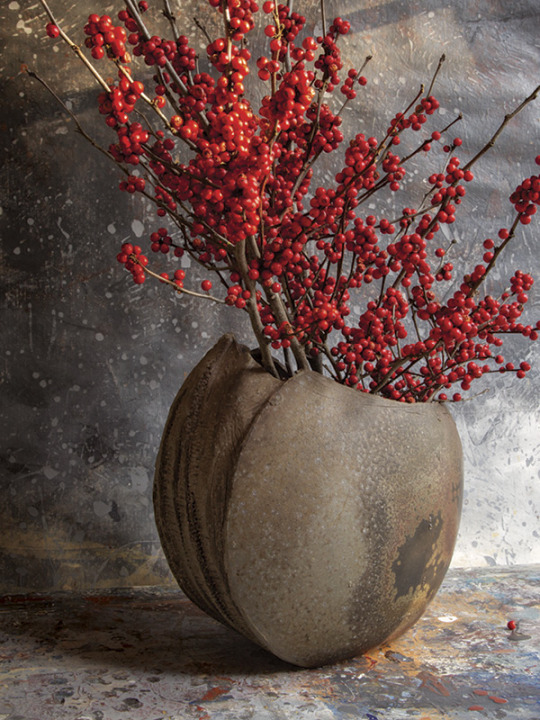
Catherine White Moon Vase
As a young potter, I was inspired by pilgrim flasks, first encountering those made by Bernard Leach. Searching for the seeds of this idea, I found resonant historical Korean and Chinese forms. My training had focused on bowls as the basis of throwing, so I thought of these shapes as the combination of two bowls turned on edge with an added rim and foot. As I began wood firing, I was attracted to broad, shallow surfaces as a canvas for ash deposits. Though not as spherical as a traditional Korean moon jar, I have called my flatter forms “moon vases” for their moon-like allusions. We built our anagama in 1996 and for 25 years I have made these shapes, altering the feeling by exploring variations in scale, texture, rims, edges, and feet. Each firing has its own nuances, and each series of moon vases has its own focus.
from Pottery Making Illustrated Jan feb issue 2024
#pottery#ceramics#pottery making illustrated#clay#moon Vase#catherine white#art#design#woodfiredceramics
55 notes
·
View notes
Text

Many thoughts and prayers going out to the kiln gods for the one and only Emperor to have a nice time in his glaze firing.
#hyydraworks#ceramics#traditional art#pottery#illustration#handmade#fantasy#bg3 spoilers#bg3#bg3 emperor#mind flayer#baldurs gate 3#baldurs gate fanart#if he makes it through and the colors come out#he’s going to be in the etsy update#🤞🤞🤞🤞
503 notes
·
View notes
Text
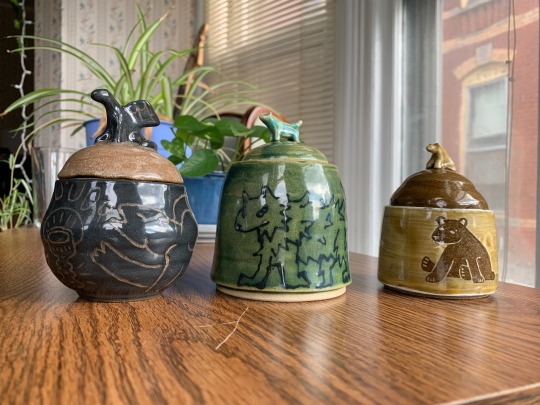

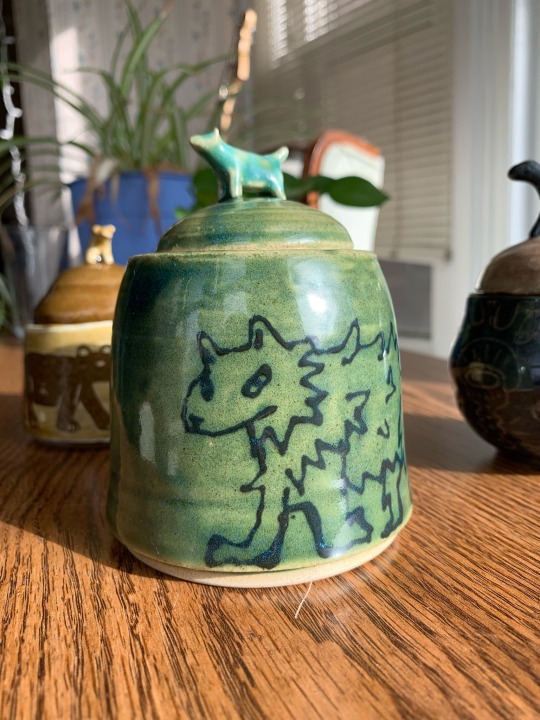
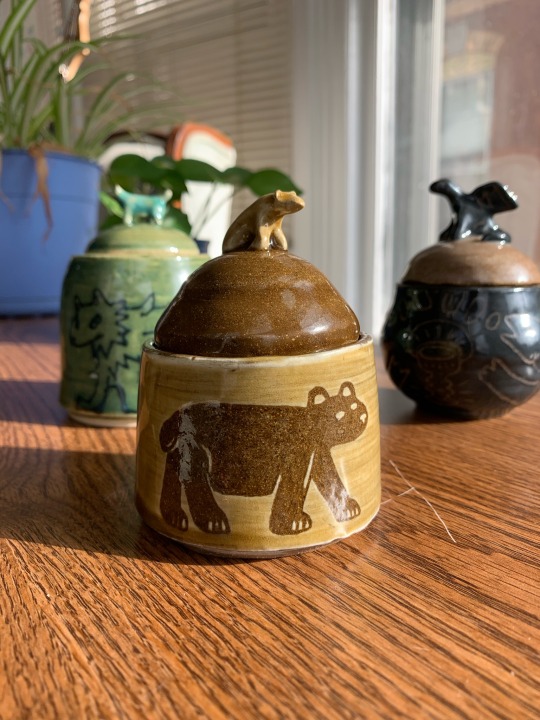
Group photo shoot: little guys on jars edition
#I’ll be posting each one separately too but I thought they looked so sweet together <3#taking advantage of being home during the day finally getting some natural light! pottery is so hard to photograph…#too shiny#you can see how much better I got at making these lol the dragon one was the first closed for jar I threw (without knowing how to at all)#then I did the bear jar which I was still struggling with but I finally watched some videos and figured it out for the dog one!#ceramics#pottery#my creations#wheelthrown#ceramic#underglaze#illustration#sgraffito#handbuilding
7 notes
·
View notes
Text
100 Things To Do Instead Of Doom-Scrolling Through Social Media
Read a book.
Write in a journal.
Learn to cook a new recipe.
Practice a musical instrument.
Start a DIY project.
Draw or paint.
Learn a new language.
Do a puzzle.
Exercise or do yoga.
Listen to a podcast.
Watch a documentary.
Play a board game.
Try a new workout routine.
Meditate.
Start a garden.
Plan a future trip.
Volunteer online.
Write a letter to a friend or family member.
Learn to knit or crochet.
Take online courses.
Practice photography.
Organize your closet.
Play video games.
Learn a magic trick.
Write a short story.
Create a vision board.
Make a playlist of your favorite songs.
Try a new hairstyle.
Experiment with makeup.
Learn to juggle.
Play a card game.
Do a home workout challenge.
Explore virtual museums or art galleries.
Do a digital detox day.
Learn calligraphy.
Rearrange your furniture.
Create a scrapbook.
Learn to play chess.
Write and perform a song.
Practice mindfulness.
Learn origami.
Plan a themed dinner night.
Do a home spa day.
Learn to code.
Play a musical instrument.
Build a blanket fort.
Take online dance lessons.
Research and try a new type of tea.
Learn about astronomy and stargaze.
Try a new board game.
Create a podcast.
Learn to solve a Rubik's Cube.
Start a blog.
Make homemade candles.
Research your family tree.
Practice a new type of art (e.g., watercolor, sculpture).
Learn to speed-read.
Write a poem.
Make a list of personal goals.
Learn to play a new card game.
Create a budget.
Build a puzzle or Lego set.
Learn to identify constellations.
Try a new fitness class online.
Make homemade pizza.
Experiment with DIY face masks.
Learn about a historical event.
Create a bucket list.
Learn to tie different knots.
Try a new type of workout (e.g., Pilates, kickboxing).
Create digital art.
Plan a themed movie marathon.
Learn to juggle.
Explore a new genre of music.
Write a letter to your future self.
Take up a new hobby (e.g., birdwatching, geocaching).
Research and try a new type of cuisine.
Make homemade ice cream.
Practice deep breathing exercises.
Create a photo album.
Try a new type of dance.
Write and perform a short play.
Learn to play a new board game.
Take a virtual tour of a historical site.
Make a time capsule.
Learn about different types of architecture.
Plan a virtual game night with friends.
Write and illustrate a children's book.
Try a new form of exercise (e.g., HIIT, Zumba).
Learn about different types of plants.
Create a DIY home decor project.
Plan a themed picnic at home.
Research and try a new type of dessert.
Practice positive affirmations.
Try a new type of puzzle (e.g., crosswords, Sudoku).
Learn about different types of birds.
Experiment with DIY skincare products.
Take up a new form of art (e.g., pottery, glassblowing).
Create a list of things you're grateful for.
Learn about a new culture.
3K notes
·
View notes
Note
More random hcs please, they are amazing
Thank you !! There you go ✨ (here's : part 1)
More random things I like to hc :
- When she's training, Diana listens to binaural beats claiming that it gives her the opportunity to train and meditate simultaneously. "It's an incredible time saving.", she'd say. Bruce would roll his eyes.
- Oliver and Hal would beg Batman to install a confessional in the Watchtower, like in reality shows. Because he obviously refuses, they'd stand in front of any security camera and use them as one, rambling on and on about the other members.
- Dick is a total extrovert. When he has some time to recharge in between day work and night vigilantism, he lets off steam in nightclubs. He took Tim (who-recharges-when-alone™) once : he hated it.
- Most of the time Dinah would show up at meetings with sunglasses to look "mysteriously cool". Actually, she can't sleep at night.
- Booster would definitely refer to himself in the third person.
- Clark being Bruce's personal masseur is one of their rituals. Whenever his super senses notice a specific tenseness in Batman's body, Clark would end up joining him in the batcave and giving him a massage session. Bruce would just accept it without a word.
- When he's not the one leading the meeting, Batman is usually snacking on a bag of nuts.
- Alfred has a workshop in the manor where he makes pottery. He makes bat-shaped objects that everyone in the Batfam loves. He made mugs, plates, jars, etc.
- Booster would use Skeets as a soundboard to accompany his every actions and illustrate his jokes. Shayera lost her temper once and broke Skeets in half. No worries, Victor helped repair him, although it was still a traumatizing experience for Booster.
- Hal has a collection of Top Gun goodies. At some point, Bruce brought him the original G-1 jacket from Tom Cruise for his birthday.
- Batman is absolutely excellent at everything he puts his mind to, except the absolute purge that is the game Sekiro. It started when Tim was raging while playing the game. Bruce passed behind him and let out a fatherly "You should learn how to control your emotions better, Tim.". Cue Tim challenging him to play. Then, there remained Batman cursing at a screen, desperately replaying a boss fight for the nth time.
- Booster and Ted have this promise that if neither one of them gets married at a certain age, they'd marry each other. Although, Ted is still looking for love, Booster is satisfied with the idea he'd end up marrying Ted.
- Oliver's neck is very often covered in hickeys.
- Constantine and Alfred are actually good buddies. They facetime a lot when Alfred is busy in the kitchen and John has some free time. That's how John knows so much about Bruce.
- The batfam plays a game where they make up elaborate life stories for strangers they encounter in public. Using their detective skills, they later discover the real stories and the winner is the one whose made-up backstory comes closest to the truth.
- Sometimes, Victor and Clark play football together. They both loved it in the past and they both lost the opportunity to commit and progress in the field. It's just the two of them, but it still helps heal their inner teen.
#dc comics#dc#batman#bruce wayne#superman#clark kent#superbat#dick grayson#nightwing#hal jordan#green lantern#oliver queen#green arrow#booster gold#michael jon carter#ted kord#blue beetle#diana prince#wonder woman#dinah lance#black canary#alfred pennyworth#batfamily#batfam#hawkgirl#victor stone#cyborg#tim drake#john constantine#mine
270 notes
·
View notes
Text
the thing that really gets me in ep 3 is just how well the tlou team used the set design. Because when we first see Bill making this town his own, we see him going through shops and stocking up on gas. We see him setting up booby traps and security cameras. But his house, when frank first comes in to eat, is almost entirely,,,white. It's very plain and just a house, not a home. Bill is a survivalist, so clearly he's not very concerned with how the house looks and feels, just if he can survive in it. And then frank stays.
And the very first scene we see of them three years later is an argument over paint. It's frank telling him that home is how you treat your surroundings, too. That this is his street, too. And bill relents. and from then, we can see that the house becomes more colourful. the walls are blue and wine red. the curtains are golden and patterned. paintings and pottery line the walls. frank makes his house a home, and I think it really also illustrates his effect on bills life in general
#oh episode 3!! cant wait for ellie and bills funny back abd forths!!#the last of us#tlou hbo#(i will never be the same)
1K notes
·
View notes
Text
By Luke Gentile
The FBI announced last week its recovery of at least 22 historical artifacts taken after the American victory at the Battle of Okinawa in World War II.
A deal to return the artifacts to the Government of Japan, Okinawa Prefecture, was arranged via the FBI, and a repatriation ceremony will be held after the artifacts return for the first time in nearly eight decades, according to a release from the FBI Boston Division.
Several artifacts date back to the 18th and 19th centuries and hold a place in the long history of Okinawa, including portraits, a hand-drawn map, pottery, and ceramics, the release noted.
“It’s incredibly gratifying when the FBI is able to recover precious cultural property that has been missing for almost 80 years,” Jodi Cohen, the special agent in charge of the FBI Boston Division, said.
“This case highlights the important role the public plays in recognizing and reporting possible stolen art. We’d like to thank the family from Massachusetts who did the right thing in reaching out to us and relinquishing these treasures so we could return them to the people of Okinawa,” Cohen said.
Multiple artifacts now returning to Okinawa were registered with the FBI’s National Stolen Art File in 2001 by the Okinawa Prefectural Board of Education, according to the release.
In 2023, the family of a late World War II veteran (who did not serve in the Pacific) discovered some of the valuable Asian art while they went through his personal items, and they found at least four of the works in the National Stolen Art File, according to the FBI.
“It’s an exciting moment when you watch the scrolls unfurl in front of you and you just witness history, and you witness something that hasn’t been seen by many people in a very long time,” Geoffrey Kelly, an FBI Boston special agent and Art Crime Team member, said.
“These artifacts are culturally significant, they’re important pieces of Japan’s identity. These were especially important because they were portraits of Okinawan kings dating back to the 18th, 19th centuries. This case really illustrates part of the work we do on the Art Crime Team. It’s not always about prosecutions and putting someone in jail. A lot of what we do is making sure stolen property gets back to its rightful owners even if it’s many generations down the road,” Kelly said.
Assisting the FBI in the return of the items was the Smithsonian Institute’s National Museum of Asian Art, according to the release.
“The FBI reached out, asked us for some help making sure they knew how to care for the works and that they had a safe place to store them while they worked out the repatriation details. It’s an honor to be able to help the works go back to their home,” Danielle Bennett, the head of collections management at the National Museum of Asian Art at the Smithsonian Institute, said.
You can see all of the recovered artifacts here.
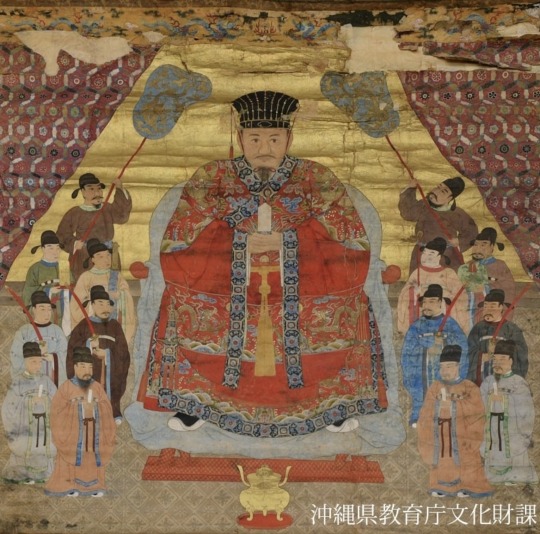
81 notes
·
View notes
Text
Hi! I'm Terv, welcome to my blog!

How to turn off "Best stuff first" so you'll actually see my posts
Here's some handy-dandy info about my stuff. Might heavily edit this later because I'm nitpicky like that lmao, but anyway, here we go!

Art tag: tervdraws
Writing tag: tervdrabbles
Personal tag: it's terv
Leonardo/Usagi tag: leoichi
AO3: katterv
Pillowfort: tervaneula
Bluesky: tervaneula
Commissions: Closed
Ko-Fi: tervaneula
Redbubble: tervaneula
❌ Do not repost or edit my art and writing! ❌
A little piece about fandom etiquette

My blog is a tcest & apritello & aprileo free zone.

Latest NQK update
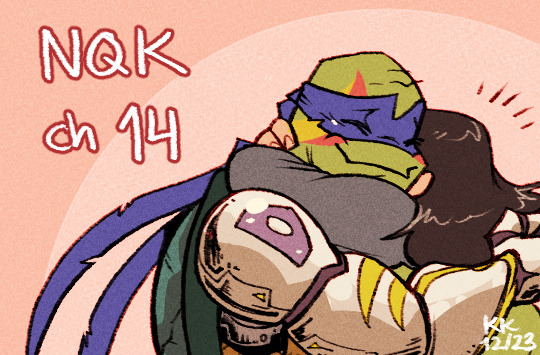
Chapter 14: Don't Worry About It

A list of my ROTTMNT related fics under the cut. Most of them are illustrated! 💜
General [9/?]
help me believe (that i'm your brother) (G)
The road to recovery has been long but finally, the brothers are well enough to introduce Future Boy to one of the most comforting of habits - the turtle pile.
Unfortunately, Casey has some doubts about his place in their family.
please don't be a hero (again) (G) (part 1 of a series)
Donatello needs his coffee. Leonardo finds him first.
lean on me (i'm strong enough) (G) (part 2 of a series)
Leonardo needs to get better, be better. If not for himself, then for Michelangelo - his baby brother shouldn't worry about him as much as he does.
you make me proud, little brother (G) (part 3 of a series)
Raphael worries and Leo's quip goes wrong. However, it leads to an emotional turnaround neither of them saw coming.
a lesson in trust (G)
Leo feels guilty for getting Raph caught by the Krang and refuses to let go of that burden. His big brother isn't having it anymore.
not quite kintsugi, but close (G) (ongoing)
The plan is simple. If all else fails, Michelangelo will make a time gateway for Casey to undo what Leonardo, in his youthful arrogance, started all those years ago; it will require sacrifice, but they are ready for it.
Until the moment comes, of course.
Or, in other words - what if Future Leonardo and Michelangelo both end up in the present with Casey?
Kintsugi (金継ぎ, "golden joinery") is the Japanese art of repairing broken pottery by mending the areas of breakage with lacquer dusted or mixed with powdered gold, silver, or platinum. As a philosophy, it treats breakage and repair as part of the history of an object, rather than something to disguise. (Wikipedia)
repeat until death (T) (Major Character Death)
A companion piece to Chapter 7 of not quite kintsugi, but close.
Leonardo doesn't want to let go. In the end, as long as Donatello is concerned, he never did.
Cold Feet (G)
Leonardo is enjoying his lazy morning… until a certain human teenager disrupts his peace.
some boys do lay eggs (T)
Leonardo is just about to fall asleep when the weight of a body thuds against the side of his bed, startling him awake, but not awake enough to shake him out of the heaviness of near slumber.
“Whassit,” he mumbles, sticking his hand out from his blankets and feeling about until his fingers touch the edge of a hard shell. Ah, he recognises the shape – it’s Leo.
“...are we boys?”
sleepless (G)
Leo is so, so tired and goes to his dad.
Splinter thinks up a plan to put into motion in the morning - but it seems that he's already helping.
Leoichi (Rise x Usagi Chronicles) [6/?]
with friends like these (G) (part 2 of a series)
Meeting up with his old friends and introducing his new boyfriend to them certainly hadn't been in Yuichi's plans for the day - but it turns out to have been a welcome surprise later when it helps him realise something important about his own feelings.
make your home in me (E) (part 4 of a series)
Click the link to read the summary!
world's end boyfriend (T) (AU)
Leonardo lost Yuichi to the apocalypse almost exactly five years ago. It's now been a year since he, Michelangelo and Casey made their impossible portal trip to the present day, successfully preventing the Krang invasion this time - so imagine Leonardo's surprise when his little brother tells him that they're going to rescue his mate.
They only have one chance.
and just like that (T) (ongoing) (part 1 of a series)
What was supposed to be a simple shopping trip to the Hidden City turns into an embodiment of a romcom when Leonardo runs into an unfamiliar white rabbit.
Or more accurately, the rabbit's dining table.
soft bunny, warm bunny, little ball of— uh oh (G) (part 3 of a series)
Leonardo feels so lucky. He has the world's softest boyfriend who doesn't mind being treated like a giant teddy bear!
Too bad it made him forget something very important.
breathe (and let go) (M) (part 5 of a series)
Leonardo needs a break from his… everything, and Yuichi is always more than happy to indulge him.
cracks never healed (they can heal now) (T)
Their plans for a nice date go awry when Leonardo and Yuichi run into a giant rampaging robot. It's swiftly dealt with, but not without a price.
well worth the wait (G)
Hana has been worried about her adoptive father's new relationship. Yuichi puts those worries to rest.
And that's it! For now. <3
#it's terv#tervdraws#tervdrabbles#rottmnt#usagi chronicles#leoichi#rottmnt fanart#rottmnt fanfiction
195 notes
·
View notes
Note
Hi there! I hope I'm doing this right with the poll idea submission. Here is my idea:
Of the following, which is a visual art form you currently most want to learn?
-A type of PAINTING (Watercolor, acrylic, gouache, oil, etc)
-A type of FIBER ARTS (Crochet, sewing, embroidery, basketry, felting, etc)
-A type of PRINT MAKING (woodcut, intaglio, etching, linocut, etc)
-A type of DRAWING (architectural, photorealism, illustration, anamorphic, Zentangle, etc)
-A type of CERAMIC/pottery-making (wheel throwing, hand building, raku, soda firing, etc)
-A type of PHOTOGRAPHY (black & white, astrophotography, landscape, portrait, macro, etc)
-A type of DIGITAL ART (pixel, photobashing, fractal, animation, vector, etc)
-Another type of CRAFT/ARTISTRY (glass making, metal working, paper making, tie-dye, jewelry making, leather working, origami, etc)
-The art form I want to learn does not fall into these categories
-I don't create visual art / Show results

75 notes
·
View notes
Text
vocab list: 미술
그림: painting, picture, drawing, sketch, illustration
페인팅: painting (영어)
페인트칠: painting (한국어)
그리다: to paint, draw, sketch a picture
끌다: to pull, draw/attract (someone's attention)
긋다: draw a line
만들다: to make (a movie, book, song), produce, direct (a movie), compose (a song)
사진: picture, photo
영화: picture, video, movie, film
영상: picture, video, image (shown on a screen)
화면: picture, image (space filled by a photo)
그림자: shadow, silhouette, reflection (on a mirror/water)
그늘: shade, dark part
미행: shadowing (secretly following someone to keep an eye on them or get evidence)
느끼다: to feel (experience an emotion in one's mind), realize, being aware of
기분: mood, feeling, atmosphere (the situation surrounding)
감정: emotion, feeling (towards a certain incident or person)
도자기: pottery, ceramics, chinaware (도기 is a bowl made of clay, and 자기 is baked at a higher temperature-1200°C-)
도예: abbreviation of '도자기 공예' -ceramic arts-
도기: pottery, earthenware
회: raw fish, round (ONLY when it's added to a number, aka a counter)
둥근: round, spheroid
차례: order, turn
계속: continuosly, consecutively
형태: shape, form, figure, appearance (of an object)
모양: shape (outer appearance/aspect) -mostly used-
형성하다: to form, build, develop a certain character or form
생기다: to be formed, come into being (something that didn't exist to come into existence)
예술: art (very broad sense, including music, painting, sculpture, architecture)
미술품: art work, fine art, work of art
미술: art (painting and sculpture)
기술: technology, skill, technique
닦다: to clean, scrub, wipe
양치: brushing teeth
붓: writing/painting brush
빗다: to brush/comb one's hair
비디오: video
텔레비전: TV
녹화: video, record, tape, videotape
무비: movie
원: circle; ₩
돌다: to turn, rotate, spin; to go around, circle
그룹: group, a circle (of people)
사회: society, circle
잉크: ink
서명하다: to sign
서명: signature, autograph
먹물: black ink (ink + water), squid ink
광장: square, plaza
사각형: square, quadrangle, tetragon, quadrilateral
평방: square (ej metros cuadrados)
제곱: square (of -maths-)
네모: square
조각: piece (of), slice; sculpture, statue
작품: piece (of music), work (of art); product, production
부분: piece, part, section, portion
하나: one, piece
하나씩: one by one, one at a time, piece by piece
일부: some/any part, portion, section, partially, partly
즐기다: to enjoy (oneself), have fun
하세요: do it, allowing someone to do something
누리다: authority to enjoy what you have in life; to enjoy someone's rights or benefits
즐겁게: delightfully
재미있다: funny, interesting, amusing, entertaining
점토: clay
진흙: mud
춤: dance (dynamic, b-boing, -방탄소년단-)
무용: dance (soft movement -ballet-)
추다: to dance
페인트: paint (pintura)
칠하다: to paint, coat, varnish
물감: paint, dye (to draw a picture or dye cloth)
색칠하다: to paint, color (something)
크레용: crayon
~을 크레용으로 그리다: to draw with crayons
~을 사생하다: to draw exactly as it is (not used in conversational korean)
주변 경치를 사생하다: draw exactly how it is viewed
사생대회: drawing/painting contest
납작한: flat (to be)
평면: plane/flat surface
아파트: flat, apartment
시시한: flat, petty, small minded; insignificant, trivial
한 푼 없는: have no money
포스터: poster
영화계: the film world (-hollywood-)
박막: a thin film (anatomical jargon)
촬영: shooting, filiming
필름: film (영화 필름, 카메라 필름, 휴대폰 액정보호 필름, etc)
행동하다: to act, behave
법률: law, act, legislation
연기하다: to act, perform (personality, behavior, etc of a role); to delay, postpone
행위: act, action (with intention, will)
대행하다: to do something for someone
source: 영단어는 관리다 app

#study#korean#koreanlanguage#koreanstudy#koreanstudying#한국어#한국어연습#한국어공부#한국어공부중#한국어배우기#korean language#한국어 배우기#한국어 공부하기#korean learning#korean langblr#learn korean#korean lesson#korean words#korean voca#korean vocabulary list#korean vocab#korean vocab list#korean vocabulary#한국어 단어#한국어 배우다#한국어 공부#한국어 어휘
296 notes
·
View notes
Note
Hi! I just found your blog and I absolutely LOVE your ceramic work. Out of curiosity, what inspired you to create illustrations on your pieces? I've noticed that you use carving techniques on some, while also doing underglaze painting on others. Which technique do you enjoy doing more?
thank you!
really, I’ve been painting for most of my life, so when I started pottery, surface decoration was easier than the actual pottery part lol. I’m pretty sure my mom introduced me to sgraffito, which is my usual carving technique.
I prefer sgraffito.
when I paint, I usually know how it’ll turn out (even though underglaze can be a bit unpredictable)
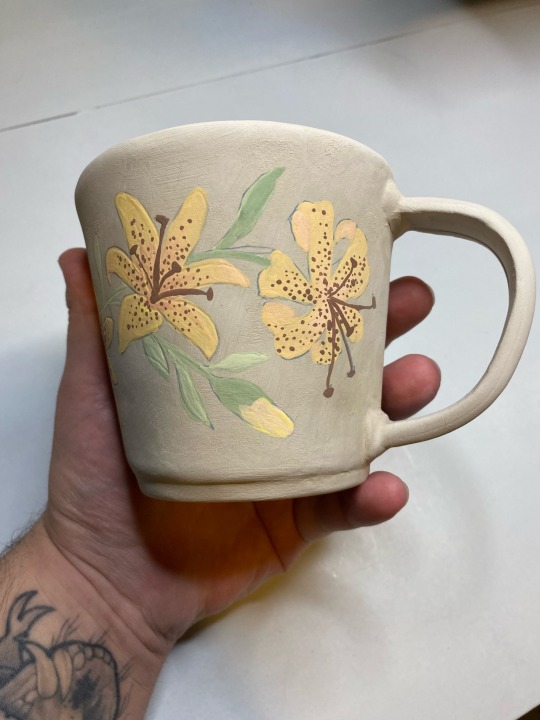
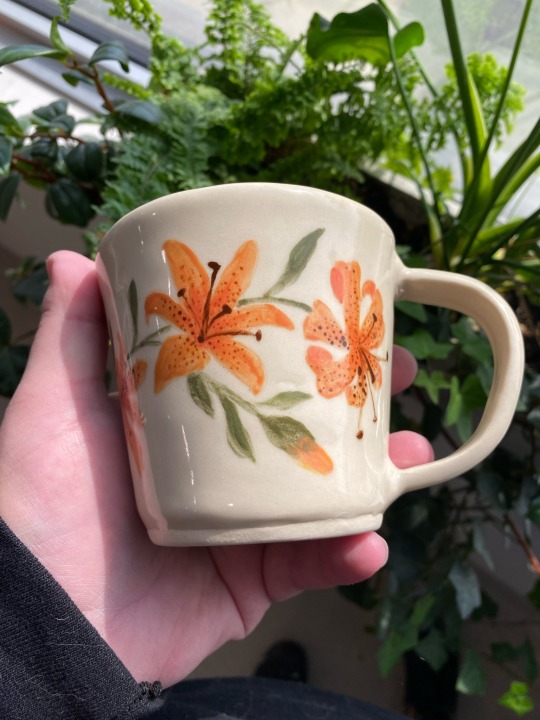
but when I carve, I don’t usually decide what stays and what gets carved until the tool is in my hand. it adds some excitement, I guess?
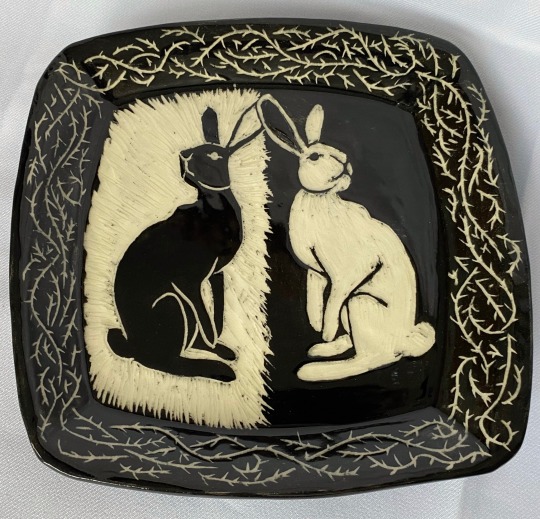
this is one of the pieces I used to demonstrate the difference when I taught sgraffito.
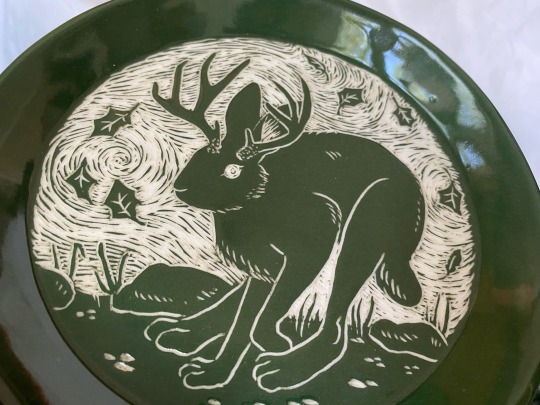

here are some more rabbitish critters. sometimes I carved away the positive space, sometimes the negative space. I feel like it gives a piece a very different feeling
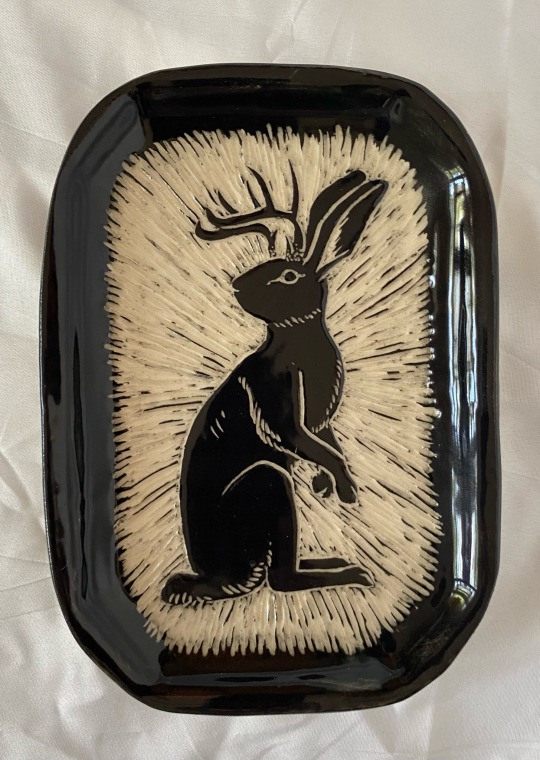

…I should make a pair of plates with the same design carved the opposite way, just to see how different they turn out!
#pottery#ceramics#sgraffito#ceramic art#underglaze painting#before and after#jackalopes#jackalope#claypigeon#ask#asks
79 notes
·
View notes
Note
Real person message!! When making your sculptures (or other things too really!) do you ever get bored of making the same kind of guy many times? And if yes, do you have a way to spice up the process, or do you prefer to just move on to something new? (I love your work a ton! Both when the types are very different but also when they are like siblings :D)
Oh man YES I do get tired of Particular Guys! Sometimes because the whole process is so labour-intensive (hello, Woodsbeasts & big Bird Ladies), sometimes just because I run out of creative steam on 'em (most recently, sphinxes), Thankfully (because the timelines of pottery are so so so long) just not making them for a batch or two will give me a minimum 6 month break & by the time I think of going back they feel fresh & exciting again.
I also have the benefit of pottery being the more flexible part of my job (I'm also an illustrator/graphic designer) - when it started to become a viable part of my practice, I promised myself that, with the exception of commissions/prepping for particular sales, most of my batches would be of whatever I felt like making at the time. As opposed to my other work, which takes the shape of particular projects (a book, a report for a client, etc), I can just tootle away at my pottery desk, sculpting weird beasts that make me happy. This has worked well for me & I plan to stick with it as an approach for the time being.
Mugs/vessels are a bit different, as the actual making of the forms almost becomes muscle memory (especially the slab-built mugs), so it feels less creatively draining. I can, however, burn out on particular types of vessel decoration, eg. the EIGHT (8?!?) medieval-marginalia inspired pieces that are in the glaze kiln as I type. They took SO LONG and by the last couple of mugs I was full-on cursing my choices (tho if they turn out well I know I'll forget all about the pain & go oooohhhh let's make more. This is how my terrible brain works).
So yeah! Burnout happens, but I don't let it worry me because I know my weird little guys can wait until I'm ready to make 'em again :)
Note: this starts with 'real person message' because in Oct 2023 I got a bunch of annoying spam messages & asked people for real asks...then I got a ton of lovely Qs & am still working through the backlog in...uhhh...April 2024. Oops/thank you for your patience?!
28 notes
·
View notes
Text
#bg3#baldurs gate 3#baldurs gate astarion#Batstarion#cute#illustration#ceramics#traditional art#pottery#handmade#fantasy#bat#wanted to make sure everyone saw that there were a couple little add ons into the Batstarion mug!#hyydraworks
241 notes
·
View notes
Text
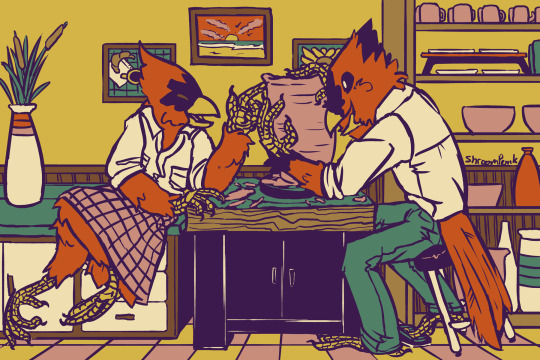
love is just a kiss away
ID: Limited palette illustration featuring two anthro cardinals in a pottery shop. On the left is a trans woman cardinal, with the red coloring of a traditional male cardinal but wearing a 1950s style plaid skirt along with a more masculine shirt. She's seated on the countertop and leaning over to scratch a line in a pot that her partner is making on a large pottery wheel, while he supports the large pot with his hands. He's leaning forward while he works, and behind him a shelving unit full of pottery waits to be fired.
81 notes
·
View notes
Text
4th October (late again oops) @prongsfoot-microfic prompt "illustrate"
Dog walk
Padfoot is a great dog. James found him abandoned in the streets several years ago and took him in. The big black German Shepherd became a very good friend, they went on morning runs every day and on walks together at the park every weekend.
"Who's a good boy? Pads, fetch!" He ran after the stick yet dropped it and left the other way. "Padfoot! Padfoot come here, boy!"
Potter sighed and went after his pet, who was bothering a stranger. "There you are! I'm so sorry, he's very social."
"Oh, no worries, mate! I like dogs." The two blokes locked eyes, recognising each other. "Oh! Potter Jr."
"Oh, hi! It's James. You're... Sirius, is it?" The question was purely out of respect. He remembered his name. In fact, he thought about him that absolutely gorgeous man since he showed up to the family's pottery class a week before.
"One and only! And who's this good boy?"
"That's Padfoot. Or Pads." Pale hands met black fur and only then did Jamie see the bloke had been drawing, his fingertips grey with coal. "You draw?"
"Oh, yeah. It's my passion. I was just sketching though. It's nothing special."
"Do you mind...?" He pointed at the sketchbook, wanting to see the drawings.
"Yeah, sure." He flipped through the pages, looking at the details of the faces of what he assumed were portraits of strangers.
He admired the coal landscapes, the depth in a single page, while keeping some key details. He skimmed through the several studies of specific things such as hands, eyes (that always looked sad), poses...
"If these are sketches, mate... Then I can't even imagine what your actual art must look like. They're bloody brilliant!"
"Oh, thanks..." Pale cheeks turned rosy and the default smirk became more shy. It was adorable, really.
"You want to be a painter or somethin'?" He gave him back the black notebook.
"An illustrator and/or animator. I also work digitally."
"Do you have any social media page?" Is it too on the nose to ask this?
"Yeah! Starsirius_art on Instagram." James took his phone and followed, smiling at the screen.
"Brill. We have to go but uh... I'll be sure to check your page!"
"Thanks, mate. See ya around. And goodbye Pads!" Padfoot seemed to like him, that makes two of us, barking while wiggling his tail. He went as far as licking the beautiful man. Lucky bastard.
#prongsfoot#marauders starbucks#starbucks ship#prongsfoot microfic#james x sirius#sirius x james#james potter#sirius black#marauders#marauders era#marauders fandom#the marauders#harry potter marauders#dead gay wizards#bambibelle
53 notes
·
View notes
Text
Anthropologist Zelia Nuttall transformed the way we think of ancient Mesoamerica
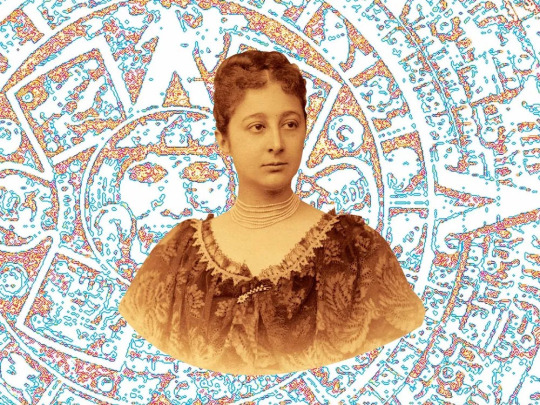
An illustration of the Aztec calendar stone surrounds a young portrait of anthropologist Zelia Nuttall. “Mrs. Nuttall’s investigations of the Mexican calendar appear to furnish for the first time a satisfactory key,” wrote one leading scholar.Peabody Museum of Archaeology and Ethnology, Harvard University
By Merilee Grindle
Author, In the Shadow of Quetzalcoatl: Zelia Nuttall and the Search for Mexico’s Ancient Civilizations
On a bright day early in 1885, Zelia Nuttall was strolling around the ancient ruins of Teotihuacán, the enormous ceremonial site north of Mexico City. Not yet 30, Zelia had a deep interest in the history of Mexico, and now, with her marriage in ruins and her future uncertain, she was on a trip with her mother, Magdalena; her brother George; and her 3-year-old daughter, Nadine, to distract her from her worries.
The site, which covered eight square miles, had once been home to the predecessors of the Aztecs. It included about 2,000 dwellings along with temples, plazas and pyramids where they charted the stars and made offerings to the sun and moon. As Zelia admired the impressive buildings, some shrouded in dirt and vegetation, she reached down and collected a few pieces of pottery from the dusty soil. They were plentiful and easy to find with a few brushes of her hand.
The moment she picked up those artifacts would prove to be pivotal in the life and long career of this trailblazing anthropologist. Over the next 50 years, Zelia’s careful study of artifacts would challenge the way people thought of Mesoamerican history. She was the first to decode the Aztec calendar and identify the purposes of ancient adornments and weapons. She untangled the organization of commercial networks and transcribed ancient songs. She found clues about the ancient Americas all over the world: Once, deep in the stacks of the British Museum, she found an Indigenous pictorial history that predated the Spanish conquest; skilled at interpreting Aztec drawings and symbols, and having taught herself Nahuatl, the language of the Aztecs and their predecessors, she was the first to transcribe and translate this and other ancient manuscripts.
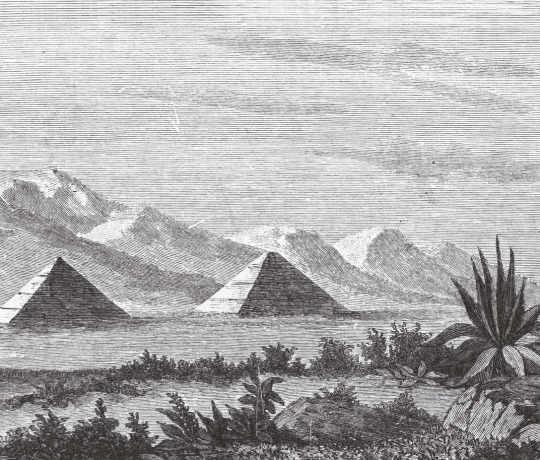
A 19th-century engraving of the pyramids of Teotihuacan. The Pyramid of the Sun was restored in 1910, on the centennial of the Mexican War of Independence. Bridgeman Images
She also served as a bridge between the United States and Mexico, living in both countries and working with leading national institutions in each. At a time when many scholars spun elaborate and unfounded theories based on 19th-century views of race, Zelia looked at the evidence and made concrete connections based on scientific observations. By the time she died, in 1933, she had published three books and more than 75 articles.
Yet during her lifetime, she was sometimes called an antiquarian, a folklorist or a “lady scientist.” When she died, scholarly journals and some newspapers ran notices and obituaries. After that, she largely passed from the public’s eye.
Today, anthropologists often have specialized expertise. But in the 19th century, anthropology was not yet a discipline with its own paradigms, methods and boundaries. Most of its practitioners were self-taught or served as apprentices to a handful of recognized experts. Many such “amateurs” made important contributions to the field. And many of them were women.
She was born in 1857 to a wealthy family in San Francisco, then a fast-growing city of about 50,000 people. Near the shore, ships mired in mud—many abandoned by crews eager to make their fortunes in the gold fields—served as hostels to a restless, sometimes violent and mostly male population. Other adventurers found uncertain homes in hastily built hotels and rooming houses. But the city was also an exciting international settlement. Ships arrived daily from across the Pacific, Panama and the east via Cape Horn.
Her well-appointed household stood apart from the city’s wilder quarters, but the people who lived there reflected San Francisco’s international character. Her mother, Magdalena Parrott Nuttall, herself the daughter of an American businessman and a Mexican woman, spoke Spanish, and her grandfather, who lived nearby, employed a French lady’s maid; a nursemaid from New York; a chambermaid, laundress, housekeeper, coachman and groom from Ireland; a steward from Switzerland; a cook and additional servants from France; and nine day laborers from China.
When Zelia was 8, her family left San Francisco for Europe. Along with her older brother, Juanito, and her younger siblings Carmelita and George, Zelia and her parents set off for Ireland, her father’s native land. Over the course of 11 years, the Nuttalls made their way to London, Paris, the South of France, Germany, Italy and Switzerland. Throughout that time, Zelia was educated largely by governesses and tutors, with some formal schooling in Dresden and London. But her time overseas shaped her interest in ancient history and expanded her language skills, as she added French, German and Italian to her fluent Spanish. All of this expansion thrilled her mind, but it also made her feel increasingly out of step with the expectations for young women of her age. “My ideas and opinions form themselves I don’t know how, and I sometimes am astonished at the determined ideas I have!” she wrote in a November 1875 letter.
She took refuge in singing and tried to be pleased with the few social events she attended. Photos from the time show Zelia as an attractive young woman with large, dark eyes, arched eyebrows and stylishly arranged hair. Nevertheless, she was unhappy. “I was infinitely disgusted with some of the idiotic specimens of mankind I danced with,” she wrote in an 1876 letter after a party.
The Nuttalls returned to San Francisco in 1876, when she was nearly 20. Two years later, she met a young French anthropologist, Alphonse Pinart, already celebrated in his mid-20s as an explorer and linguist. He had been to Alaska, Arizona, Canada, Maine, Russia and the South Sea Islands. Pinart may have led the family to understand that he was wealthy. In fact, he was almost penniless, having already spent his significant inheritance.
They were married at the Nuttall home on May 10, 1880. During the next year and a half, the couple traveled to Paris, Madrid, Barcelona, Puerto Rico, Cuba, the Dominican Republic and Mexico. Pinart introduced Zelia to a burgeoning academic literature in ethnology and archaeology, and she began to understand the theories of linguistics. She found 16th-century Spanish hardly a challenge as she consulted annotated codices—pictorial documents that traced pre-Columbian genealogies and conquests in Mesoamerica. While Pinart dashed from project to project and roamed widely among countries, tribes and languages, Zelia began to demonstrate an intellectual style that was more focused and precise.
Despite the excitement of discovery, something began to go wrong in the marriage. Hints of Zelia’s distress can be found in her effusive letters home. There was, for example, the shipboard admission that her husband was less attentive than she had anticipated. She noted that he was “so quiet and undemonstrative” that it was hard to imagine they were newly married. Some fellow passengers thought they were brother and sister—an odd assumption to make, even in Victorian times, about newlyweds.
By contrast, Zelia is nowhere to be found in Pinart’s surviving correspondence. On April 6, 1881, she gave birth to a daughter, Roberta, who lived only 11 days. To add to this melancholy time, her beloved father died in May, leaving her doubly devastated. A letter Pinart wrote to a friend just a few months later from Cuba appeared on stationery with a black border, signifying mourning, but he made no reference to his wife, her father or their child.
Zelia found solace in learning about her heritage when she and Pinart traveled to Mexico in 1881. She was eager to see her mother’s homeland and to hone her understanding of its pre-Columbian cultures. While Pinart carried out his own research, she began to learn Nahuatl, and she toured villages where dialects of the language were still spoken and ruins where the marks of the past could still be found.
The couple returned to San Francisco on December 6, 1881. By then, Zelia was pregnant again. In late January, Pinart set out to spend several months in Guatemala, Nicaragua and Panama, while Zelia awaited the birth of her second child, Nadine, at her mother’s house.
What finally drove Zelia to sue for divorce, on the grounds of cruelty and neglect, remains elusive. She may have felt that Pinart had married her for access to her family’s fortune. Many years later, she angrily informed Nadine that Pinart had spent the $9,000 she had inherited from her father as well as her marriage settlement. When the money was gone, and when her family was firm that he shouldn’t expect any more, he abandoned his wife and child. Once Zelia demanded a separation, he did not contest it, though obtaining the divorce was a long process that started soon after the couple’s return from their travels and didn’t conclude until 1888.
In later life, Nadine Nuttall Pinart would reflect on how much it had cost her to grow up without a father. “From the time before I can remember, he was taboo to me,” she wrote in a 1961 letter to Ross Parmenter, a New York Times editor who wrote numerous books about Mexico and developed a fascination with Zelia Nuttall. “I was frightened by the violent scoldings I got for mentioning his name. Later, I compromised with myself and when asked about him quietly said, ‘I never knew him!’ I realized that people thought he was dead and were sorry for me and said no more. In those days it was a disgrace to have a divorced mother.”
If the period between 1881 and 1888, when Zelia finalized her divorce, was fraught with tension and heartache, this was also when she set about redefining herself as a woman with a vocation. She spent five months in Mexico with her mother, her daughter and her brother between December 1884 and April 1885, visiting Cuernavaca, Mexico City and Toluca, and exploring archaeological ruins. It was during this time that Zelia made her fateful winter visit to Teotihuacan and acquired her first artifacts.
The pieces of pottery she picked up that day were small terra-cotta heads. They were abundant in the area among the pyramids. At the time, the site was still being used as farmland, and the artifacts came to the surface during ploughing. The heads themselves were an inch or two long, with flat backs and a neck attached. Scholars before Zelia—Americans, Europeans and Mexicans—had mused creatively about such relics, describing differences in their facial features and the variety of headdresses they had sported. Drawing on 19th-century fascination with the topic of race, the French archaeologist Désiré Charnay became convinced that he could see in them African, Chinese and Greek facial features. Charnay mused: Had their creators migrated from Africa, Asia or Europe? And if racial identity was a marker of human development, as many believed at the time, what might this curious mixture of features reveal about civilizations in the Americas?
This kind of thinking was typical. Mistaken ideas about Darwinism led many Western scholars to believe that civilizations evolved along a linear, hierarchical path, from primitive villages to ancient kingdoms to modern industrial and urban societies. Not surprisingly, they used this to legitimize beliefs about the superiority of the white race.
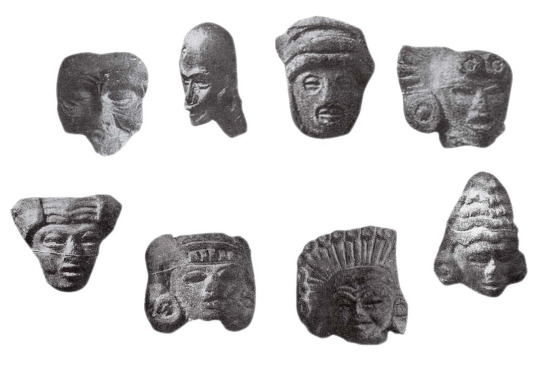
Zelia Nuttall divided her collection of terra-cotta heads into three classes. The first included rudimentary efforts to represent a human face (as seen above, far left). The second class (including the bald second head from the left above) had holes for attaching earrings and other ornaments. The third category included the rest of the heads pictured here, sporting what Zelia called “a confusing variety of peculiar and not ungraceful headdresses.” Public Domain
Zelia generally accepted her era’s assumptions about race and class, and she was comfortable with her elite status and its privileges. Yet in her research, she did not categorize civilizations as primitive, savage or barbaric, as other scholars did, nor did she indulge in racial theories of cultural development. Instead, she sought to sweep aside this kind of speculation and replace it with observation and reason.
The more Zelia examined her terra-cotta heads, the more she realized she needed guidance from someone who had more experience in the study of antiquity than she had. At the time, there were no departments of anthropology in colleges or universities, no degrees to be earned, no clear routes to building a career. To pursue her burgeoning interest in the ancient civilizations of Mexico, and to decipher the meaning of an assortment of terra-cotta heads, she contacted Frederic Ward Putnam, the curator of Harvard’s Peabody Museum of Archaeology & Ethnology and a leading expert on Mesoamerica. He agreed to meet her in the fall of 1885. The meeting was all she hoped for: Putnam warmed to her work and encouraged her to follow her intuitive grasp of how to observe and interpret evidence.
Putnam’s regard for women’s intellectual capacities was clear. He was one of a small number of Harvard researchers who gave lectures at “the Annex,” an institution established for women who had passed the college’s admissions test but were not allowed to attend classes or earn a degree. (The Harvard Annex eventually became Radcliffe College.) He hired a resourceful administrative staff of women and encouraged them to play a role in managing the museum. He also had a “correspondence school,” which he conducted through a widespread exchange of letters. As he once wrote, “Several of my best students are women, who have become widely known by their thorough and important works and publications; and this I consider as high an honor as could be accorded to me.”
Within months of their first encounter, in late 1885, Putnam asked Zelia to become a special assistant in Mexican archaeology for the Peabody. Less than a year later, in the annual report of the Peabody Museum, he wrote about her appointment in glowing terms: “Familiar with the Nahuatl language … and with an exceptional talent for linguistics and archaeology, as well as being thoroughly informed in all the early native and Spanish writings relating to Mexico and its people, Mrs. Nuttall enters the study with a preparation as remarkable as it is exceptional.”
With guidance from Putnam, Zelia wrote an investigation of the terra-cotta heads, her first published scientific report, which appeared in the spring 1886 issue of the American Journal of Archaeology. “At the first glance,” she wrote, “the multitude and variety of these heads are confusing; but after prolonged observation, they seem to naturally distribute themselves into three large and well-defined Classes.”
Each class, she theorized, had been created at a different time and represented a different stage in the culture. The first class contained “primary and crude attempts at the representation of a human face.” The second class included the first efforts at artistry. Her inspection revealed “holes, notches and lines,” suggesting ways in which tiny headdresses, feathers or beads could have been attached to the heads, and noted traces of several colors of paint and different kinds of clay.
The third class was the most important, Zelia argued, because of the quality of the molding and carving. This class had “modifications of feature sufficient to give every specimen an individuality of its own,” she wrote. “The faces are invariably in repose, in some the eyes are closed … faces young and smooth, others very elongated, some with sunken cheeks, others with wrinkles.”
By comparing these terra-cotta heads with ancient pictographs and writings, she showed that some of the heads represented children while others depicted young men, warriors or elders. Others showed the distinct hairstyles described in the writings of Bernardino de Sahagún, a 16th-century Franciscan friar who spent 50 years studying the Aztec culture, language and history. “The noblewomen used to wear their hair hanging to the waist, or to the shoulders only. Others wore it long over the temples and ears only,” Sahagún had written. “Others entwined their hair with black cotton-thread and wore these twists about the head, forming two little horns above the forehead. Others have longer hair and cut its ends equally, as an embellishment, so that, when it is twisted and tied up, it looked as though it were all of the same length; and other women have their whole heads shorn or clipped.”
These concrete observations allowed Zelia to challenge popular ideas about the supposed African, Asian, European or Egyptian origins of the “races” in the Americas. For example, by studying the ornamentation the heads displayed, she was able to identify the person or god each artifact represented and interpret its ritual or symbolic purpose. One clearly corresponded with Tlaloc, the pan-Mesoamerican god of rain, who had been shown in the pictographs with a curved band above the mouth and circles around the eyes. Another head, molded with a turban-like cap, corresponded with the goddess Centeotl; Zelia speculated that the clay turbans once had real feathers attached. She also noted the significance of various poses. “In the picture-writings, closed eyes invariably convey the idea of death,” she wrote.
The article revealed how Zelia intended to be seen as a scholar. First, she made it clear that she had read what others had written. Then she revealed that she would go beyond existing speculation to answer questions that had puzzled others; hers was to be original and important work.
In 1892, Zelia presented a paper in Spain about the Aztec calendar stone. Buried during the destruction of the Aztec Empire, the calendar stone had been unearthed in December 1790, when repairs were being made to the Zócalo, Mexico City’s central plaza. The sculpted stone, some 12 feet in diameter and weighing 25 tons, became a popular attraction exhibited in the Mexico City Cathedral, steps from where it had been found. Antonio de León y Gama, a Mexican astronomer, mathematician and archaeologist, had written about its discovery and praised the intelligence of the Aztecs who had created it. Alexander von Humboldt, who saw the stone when he visited Mexico in 1803-1804, included a drawing in his Views of the Cordilleras and Monuments of the Indigenous Peoples of the Americas, published in 1810, and encouraged Mexican intellectuals to study the meaning of its concentric circles and numerous glyphs. Many others took on its puzzles in the years that followed.
At the time of Zelia’s presentation, the Mexican upper classes were carefully crafting a new national image—a story that would allow Mexico to take its place among the modern nations of the world. The Aztecs, Maya, Olmecs, Toltecs, Zapotecs and other cultures had left their imprints throughout the country in magnificent temples, enigmatic statues, gold jewelry, jade figurines and painted murals. This history was reclaimed as a national heritage every bit as glorious as those of Greece and Rome. A statue of Cuauhtémoc, the Aztec king who resisted Cortés, took its place on Mexico City’s elegant Paseo de la Reforma in 1887. The calendar stone had been installed in a place of honor in the National Museum in 1885. But little was known about the actual customs and beliefs of those ancient people.

The Aztec calendar stone, a central focus of Zelia’s research, has been on display at Mexico City’s National Museum of Anthropology since 1885. Alamy
With her extraordinary knowledge of surviving codices, Zelia offered a novel “reading” of the giant calendar stone that had stumped others and provided new insights into the annual and seasonal cycles of daily life in ancient Mexico, illuminating the cosmology, agriculture and trade patterns of the Aztecs. She presented another version of the paper at the World’s Columbian Exposition in Chicago in 1893.
Zelia returned to Mexico City in February 1902, and after a personal audience with Mexican President José de la Cruz Porfirio Díaz, arranged by the U.S. ambassador, she embarked on a spree of travel to archaeological sites she had long wanted to visit. In May, she and 20-year-old Nadine joined friends at the Oaxacan ruins at Mitla, a religious center, where the “place of the dead” harbored both Mixtec and Zapotec art and architecture. On this dry, high plain ringed by mountains, Zelia strolled across vast stone patios, inspected the elaborate geometric friezes that lined and decorated them, explored temples and imagined a sophisticated society of kings, priests, nobles, artisans and farmers.
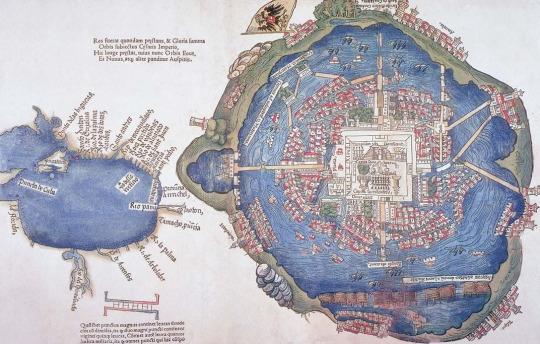
When the Spaniards arrived in Mexico in the 16th century, the Aztec Empire dominated the area. This map of its largest city, Tenochtitlan (now the historic center of Mexico City), was printed in 1524 in Nuremberg, Germany, likely based on a drawing by one of Hernán Cortés’ men. It shows the city’s elaborate network of roads, bridges and canals, complete with aqueducts and bathhouses. The Spaniards executed the last Aztec ruler, Moctezuma II Xocoyotzin, and forced his people to convert to Catholicism. Alamy
Zelia was welcomed into the international community of anthropologists in Mexico. She and Nadine traveled in the Yucatán with the young American anthropologist Alfred Tozzer, where they were beset by frequent rain and terrible roads. Arriving tired and wet in a small town, Tozzer, who would one day chair Harvard’s department of anthropology, was impressed by the women’s resilience. “Imagine the picture,” he wrote to his family on April 8, 1902. “Mrs. Nuttall, never accustomed to roughing it, a woman entertained by the crowned heads of Europe, sitting at a bench with the top part of my pajamas on drinking chocolate and her daughter with a flannel shirt of mine on doing the same.”
After a few months, Zelia and her daughter returned to Mexico City and purchased a mansion they called Casa Alvarado, in the upscale suburb of Coyoacán. The grand house never failed to impress. Frederick Starr, an anthropologist from the University of Chicago, was one of many who found the palace beautiful and restful: “We rode out to Coyoacán where we found Mrs. Nuttall and her daughter really charmingly situated. The color decoration is simple and strong. Nasturtiums are handsomely used in the patio and balcony effects. … While Mrs. Nuttall dressed, Miss Nuttall showed us through the garden, where a real transformation has been effected.”
Living in Mexico energized Zelia. In addition to her affiliation with Harvard, she had funding to travel and collect artifacts for the Department of Anthropology at the University of California. “With me here, in touch with the government and people, I think that American institutions can but profit and that I can do some good in advancing Science in this country,” she confided to Putnam.
Impressed by her knowledge of the country’s past, public officials and foreign visitors came to see her and listened carefully as she led them around her home and garden, explaining the collection she was busy assembling. Her garden, patio and verandas were home to an increasingly large number of stone artifacts, a beautiful carving of the serpent god Quetzalcóatl, revered for his wisdom, among them. She took up “digging” near Casa Alvarado, an activity one guest later recalled fondly. “Every morning after breakfast Mrs. Nuttall would give me a trowel and a bucket. She herself was equipped with a sort of short-handled spade, and we would go out into the surrounding country and ‘dig.’ We mostly found broken pieces of pottery, but she seemed to think some of them were significant, if not valuable. … She was a very handsome woman and very charming. She lived in great style, with many Mexican servants.”

The Codex Borgia, an accordion-folded document of Aztec life, was brought to Europe during the Spanish colonial period. Made of animal skins and stretching 36 feet when unfolded, the codex catalogs different units of time and the deities associated with them. It also includes astrological predictions once used for arranging marriages. Zelia drew on the codex to help her decode the Aztec calendar. Courtesy Ziereis Facsimiles

A section from the Codex Borgia
Zelia continued to travel throughout the country. She found a 14-page codex painted on deerskin, with commentary in Nahuatl, that she believed so valuable that she bought it with her own money, selling some of her possessions to afford it. “Owing to my residence here I must keep it a profound secret that I possess and sent out of the country this Codex,” she wrote to Putnam.
While she was not above smuggling treasures out of Mexico, Zelia also worked in the National Museum, contributing to its displays and archives, and she became an honorary professor of the institution.

Zelia had never owned a home until she bought Casa Alvarado in 1902. In a letter, she described the property as “a beautiful old place with extensive gardens.” Smithsonian Archives
Her Sunday teas at Casa Alvarado were a study in salon orchestration. “She would have 30 or 40 people and she would change the groups she invited,” one visitor recalled. “Sometimes they were all people who knew each other. Or else she would bring people together she wanted to introduce to each other. They weren’t like old-style Mexican parties, with all the women on one side and men on the other. The men and women were mixed together.”
According to an oft-repeated legend, at one of her soirées, she advanced to welcome an eminent guest just as her voluminous Victorian drawers came loose and dropped to her ankles. She calmly stepped out of them and proceeded as if nothing had happened. Zelia was, above all, self-confident.
Zelia Nuttall left Mexico during the early months of 1910 and did not return to her beloved Casa Alvarado for seven years. Throughout that time, Mexico was in the midst of a violent revolution. As many as two million people lost their lives in the ten-year conflict, and the country’s infrastructure was reduced to tatters. Even after the end of the most extensive violence, turmoil erupted sporadically until the late 1920s.
By then, visitors to Casa Alvarado agreed that Zelia was rooted in a bygone era. She was a middle-aged woman with thick glasses who favored shawls, laces and jet beads. Her palace was still filled with stuff only a Victorian could accumulate, but Mexico was telling new stories about itself.

The writer D.H. Lawrence used Zelia as a model for a fictional character—“an elderly woman, rather like a Conquistador herself in her black silk dress and her little black shoulder-shawl.” Antropo Wiki
The elites of the previous generation had asserted that descendants of the Aztec, Maya and other civilizations deteriorated into poverty and abandon. Young artists and intellectuals now rejected this belief. In Diego Rivera’s vast public murals, he showed the people of Mexico being ground into poverty and submission by Spanish conquistadors, a rapacious church, foreign capitalism, the army and cruel politicians. Quetzalcóatl replaced Santa Claus at the National Stadium; Chapultepec Park hosted Mexico Night.
Zelia did not like the revolution and she did not approve of what came after it. She did not celebrate the masses; she believed in hierarchy and a natural order of classes and races. Yet she was determined to be relevant to a new era in Mexico. Casa Alvarado became a meeting place for politicians, journalists, writers and social scientists from Mexico and abroad, many of whom came to witness the possibilities of change in the aftermath of a people’s revolution.
Nevertheless, the stubborn elegance of Casa Alvarado in the 1920s was clear testimony that Zelia was not willing to give up her lifestyle. When the French American painter Jean Charlot was a guest at one of Zelia’s teas, he was aghast at the Mexican servants in white gloves.
When Zelia Nuttall died in 1933, the U.S. consul in Mexico City wrote to Nadine—by then a 51-year-old widow living in Cambridge, England—assuring her that they’d given her mother a tasteful funeral. “Your Mother was very highly thought of here, as evidenced by the floral offerings and the number of her friends who came to the funeral service at the cemetery, it being estimated that about one hundred persons were present.”
By that time, the field of anthropology was dramatically changing, becoming more systematic and organized. Those who entered the field in the 1920s and 1930s built expertise in the classroom and under supervision in the field, passing a variety of tests and milestones determined by academic experts and acquiring a credential as proof of the right to pursue these inquiries. With these rigorous new standards, they asserted their superiority as scholars over those of Zelia’s generation.

Researchers thought this item at Vienna’s Museum of Ethnology was a “Moorish hat” before Zelia identified it as a Mesoamerican headdress. Alamy
Yet Alfred Tozzer, in his memorial in the journal American Anthropologist, reflected that Zelia “was a remarkable example of 19th-century versatility.” She was wrong in some of her overarching theories. For instance, she fallaciously argued that ancient Phoenician travelers had carried their culture to Mesoamerica. But she was right about many other things. Through her letters, articles and books, we can trace what she got right and what she got wrong as a scholar, and we can follow her as she moved from one research obsession to the next.
Her private life is harder to grasp. Among all the artifacts, there is little about the quips and gossip she exchanged with friends, the piano music she liked to play and sing. We cannot know what was in the boxes of papers in the cellar of Casa Alvarado that were burned in the housecleaning undertaken by its new tenants. We cannot retrieve personal and public documents lost in the San Francisco earthquake in 1906.
What we do know is that she had to make sacrifices, often very personal ones. We can feel her vulnerability, uncertainty, anger and embarrassment in the letters she wrote, as well as her self-assuredness. It required unusual self-discipline to learn so many languages and to gain a mastery of ancient pictographs. Her almost constant travels imperiled her health even while they advanced her vast network of friends, colleagues and patrons. But she continued to work, and that work helped establish the foundation on which many others now build.
A single mother pursuing a career while looking after a family in a man’s world: In some ways, Zelia Nuttall was a very modern woman.
Adapted from In the Shadow of Quetzalcoatl: Zelia Nuttall and the Search for Mexico’s Ancient Civilizations by Merilee Grindle, published by The Belknap Press of Harvard University Press. Copyright © 2023 by Merilee Grindle. Used by permission. All rights reserved.
#Women in history#Women in Anthropology#Zelia Nuttall#The Aztecs#Merilee Grindle#In the Shadow of Quetzalcoatl: Zelia Nuttall and the Search for Mexico's Ancient Civilizations#Books by women#Books about women#teotihuacan#mesoamerica#Nahuatl#Published women#Many of the first anthropologists were women#Alphonse Pinart was just another man who blew through his money#Women's careers flourishing after dumping a parasitic man#Frederic Ward Putnam#Men who encouraged women#The Annex#Lady scientist
40 notes
·
View notes